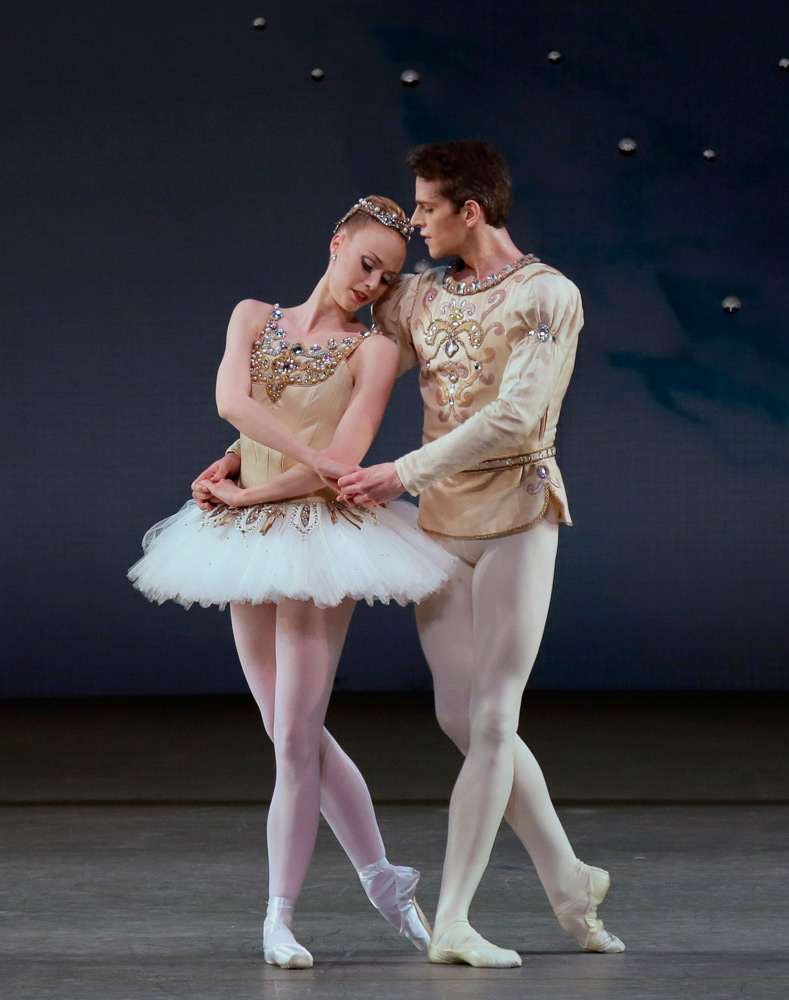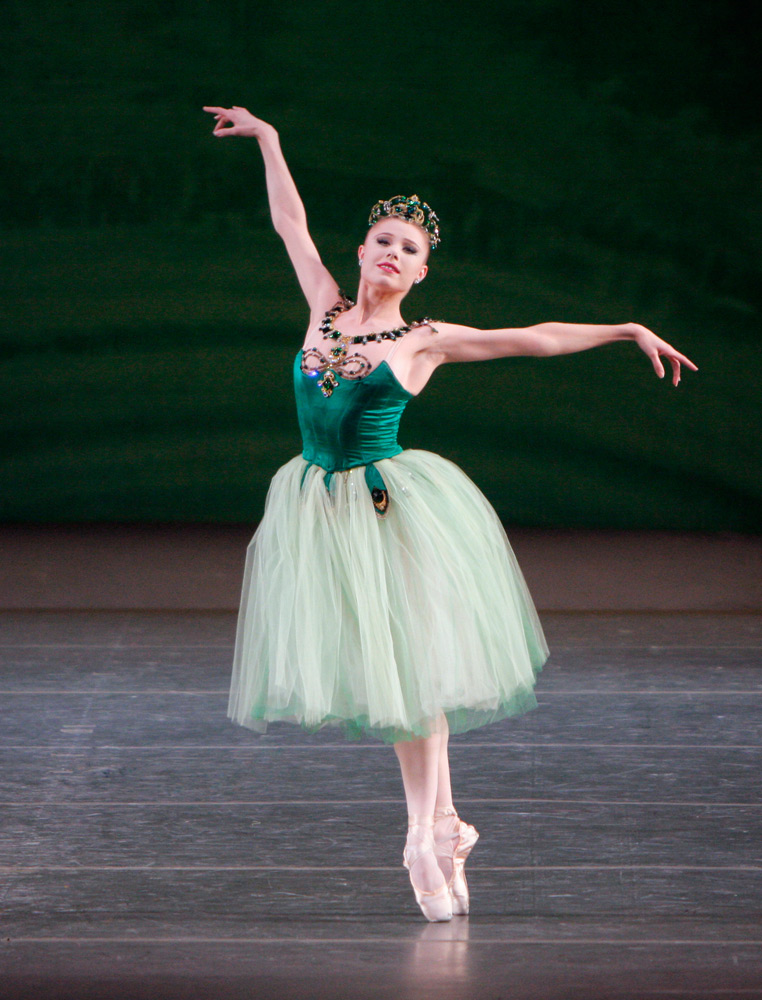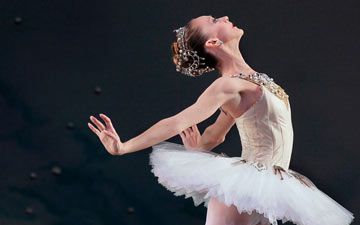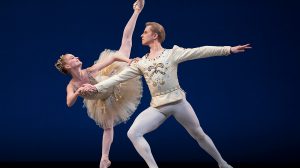
© Paul Kolnik. (Click image for larger version)
New York City Ballet
Jewels: Emeralds, Rubies, Diamonds
★★★✰✰
New York, David H. Koch Theater
27 April, 1 May 2016
www.nycballet.com
davidhkochtheater.com
Balanchine, the Jeweler
What do you do with a problem like Jewels? This 1967 blockbuster by George Balanchine is a hard one to pull off. First of all, it’s really three separate ballets, with three casts. For it to reach its desired effect, you need at least five ballerinas who are not only capable of dancing the choreography but are also suited to the roles. I confess I have yet to see such a cast.
A little background. Jewels was created in 1967 as a kind of “concept ballet” shrewdly calculated to bring in the crowds, which it succeeded in doing. The idea, cooked up with Van Cleef & Arpels, was to capitalize on the glamor and allure of gemstones: emeralds, rubies, and diamonds. (Originally there were to be other stones as well, but only three made the cut.) Balanchine had another, less obvious agenda, or rather several. One was to evoke three contrasting moods by deploying distinct styles of ballet.

© Paul Kolnik. (Click image for larger version)
To do this, he selected the music of three composers, Gabriel Fauré, Igor Stravinsky, and of course, Peter Ilyitch Tchaikovsky. Each score was a portal into an imaginary world, with its own sensations and mythologies. Fauré’s incidental music suggested a mythical France. As Verdy put it once in a coaching session captured on film, “it’s the Bretagne of Mélisande, almost aquatic, with its wave-like, seaweed-like movements.” The Stravinsky Capriccio for Piano and Orchestra was New York, sassy, sporty, and sexual. Diamonds was imperial St. Petersburg, the Silver Age, Russia, in all its formality and grandeur.
The final ingredient was, as always, his selection of ballerinas. It’s unlikely that anyone could surpass Violette Verdy in Emeralds or Suzanne Farrell in Diamonds. But no-one should be forced to compete with the past; it is, by definition, an unfair comparison. And there are great dancers at New York City Ballet today. So why is it so difficult to see a truly satisfying performance of Jewels?
There are probably a million reasons, including impossible expectations, but here are two hypotheses: a shortage of in-depth coaching and limited rehearsal time. In every performance there are two or three dancers who make you sit up and take notice, who capture the nuance and perfume of their roles, and of the ballet as a whole. Then, there are highly capable dancers who do the steps, an approach that only gets you so far. And finally, a corps de ballet that looks like it is just skimming the surface.

© Paul Kolnik. (Click image for larger version)
Rubies is the surest hit. It’s sharp, syncopated and high-spirited. These are all qualities the company has in spades. Just this week, I saw two very good performances (April 27 and the May 1 matinée). There were imperfections, understandable given that both shows included débuts. On April 27, Sterling Hyltin and Andrew Veyette, old hands, looked good together in the pas de deux, with its references to horse-racing and rope-jumping; they’re both frisky, confident and fearless. Hyltin has a strong sense of style, and a way of toying with the music and with the ballet’s Art Deco shapes, emphasizing the vernacular style of the Charleston and the tango. Veyette is an able partner and a great showoff. Megan LeCrone, débuting in the role of the Amazonian vamp – a woman who requires four partners, or none at all – is stylish (and limber) but lacks a sense of fun. Rubies is a romp, after all.
The May 1 matinée featured a host of débuts, including a very convincing Lauren Lovette paired with Anthony Huxley in the Rubies pas de deux. He’s a beautiful dancer; everything he does is clearly etched and finished, but he’s not extroverted enough for this role and his partnering skills are rough. There were some hairy moments. Lovette, who is looking stronger since her return from an injury, made the role fun and sexy, pawing the floor like a thoroughbred and jutting her hips forward provocatively. She also uses her eyes better than anyone else in the company. Emily Kikta, a corps-member débuting in the Amazonian role, was suitably forceful. She’s probably the tallest woman in the company – and taller than many of the men. This is a role she was born to dance.

© Paul Kolnik. (Click image for larger version)
The company’s two radiant blondes, Teresa Reichlen and Sara Mearns, are the reigning queens of Diamonds, a ballet that combines elements of Swan Lake and Sleeping Beauty with something altogether more mysterious. Who is the ballerina in Diamonds? A remote and melancholy queen who dreams of faroff lands and barely deigns to glance at the prince kneeling before her. Reichlen and Mearns have different takes on the role. Mearns is forceful and dramatic, Reichlen pliant and elusive, with a deep, deep backbend and a body that bends, seemingly effortlessly, into, long, oblique shapes. Reichlen was well paired with Russell Janzen, a dancer with natural gravitas.
In both Diamonds and Emeralds, though, the corps lacked focus; the dancers did the steps but little more. It was especially noticeable in Diamonds, where the ensemble plays a larger role. The opening waltz felt endless, and the Russian dance in the scherzo didn’t have much Russian feeling. The biggest problem, though, is in Emeralds. It is the most difficult of the three ballets, the most dependent on atmosphere. This, after all, was Verdy’s ballet, a ballet full of quiet mystery, wrought from a combination of impulsiveness, restraint and wonder. In the two casts I saw, only Ashley Laracey, débuting in the second ballerina role (Mimi Paul’s) on May 1, captured the ballet’s inwardness. She danced her solo – full of little reverences and small gestures – and the “walking” pas de deux that followed, as if lost in a dream. Her partner, Andrew Scordato, was elegantly understated.

© Paul Kolnik. (Click image for larger version)
There were other débuts as well, most notably Kristen Segin, Harrison Ball, and Indiana Woodward in the sprightly trio. Ball looks increasingly like a promising leading man; Woodward dances with winning lyricism and softness. But individual performances aren’t enough to make this ballet come alive. Too often, Emeralds looks simply pretty. (The cartoonish and over-bright sets could use a makeover as well.) There is a famous solo in which the first ballerina begins by moving only her arms and hands, like a beautiful woman admiring her own charms. These days, it feels decorative and fussy rather than private and impulsive. “Je faisais des ondes” (I used to make waves), Verdy, who died earlier this year, used to say. Where are the waves?

















You must be logged in to post a comment.